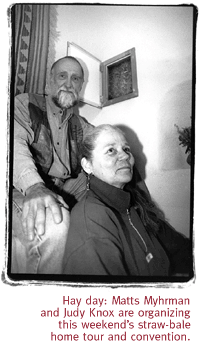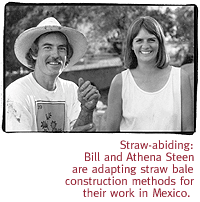
Tucson is on its way to becoming the world's center for straw-bale construction.
By Kay Sather
JUDY KNOX AND her husband Matts Myhrman say Tucson is on
its way to
becoming known world-wide as the center--if not quite the
birthplace--of straw bale construction. This weekend Out on Bale,
the straw bale education organization they founded here in 1991,
will host a home tour and gathering of the movement's practitioners
from all over the world.
The first straw bale structures were built in Nebraska in the
late 1800s by pioneers who considered them a temporary answer
to their need for shelter in areas where wood, and sometimes even
sod, was in short supply. Tucsonans Knox and Myhrman were among
the first to recognize the potential of the nearly-forgotten "stop-gap"
building material to satisfy present-day needs: it's highly insulative,
inexpensive, simple, solid, organically beautiful and environmentally
beneficial.
Knox says it all started one "innocent weekend" in
Oracle 10 years ago. Myhrman, a geologist/hydrologist with an
interest in ecological building, had seen a bale home in New Mexico
and knew immediately he wanted to build that way. So he and Knox
met with three others having some knowledge of the medium--Bill
Steen, David Bainbridge and Pliny Fisk--to talk about building
a straw bale structure themselves. Realizing then that they didn't
have quite enough information, Knox and Myhrman headed for Nebraska
to see what they could learn from the old bale buildings there,
some of which are still in use.
 They returned to Tucson with first-hand information and enough
photographs to fuel a respectable slide show. The next step was
a couple of workshop/wallraisings, and by the end of 1991 they'd
built a home for Dan Dorsey--a 475-square-foot, legally permitted
structure on Tucson's west side.
They returned to Tucson with first-hand information and enough
photographs to fuel a respectable slide show. The next step was
a couple of workshop/wallraisings, and by the end of 1991 they'd
built a home for Dan Dorsey--a 475-square-foot, legally permitted
structure on Tucson's west side.
Knox still speaks with fresh, contagious enthusiasm about her
work, and it's not hard to see why one of her trips to the dentist
that year resulted in an article in The Arizona Daily Star.
(The hygienist's husband was editor of the Star's Home
Page.) A feature story in the Tucson Weekly and then an
article in The New York Times soon had the Out on Bale
phone ringing out of control.
"The Times told us they'd hardly ever gotten so inundated
by phone calls," Knox says. "That was when our lives
went into a crazy what-did-we-get-ourselves-into kind of thing."
 Knox and Myhrman rose to the challenge, expanding their workshop
schedule, setting up a mail-order resource center, and publishing
a newsletter called The Last Straw. In 1993 they built
Mom's Place, a guest house for Myhrman's mother, and the crew
waved to friends around the country through the cameras of Good
Morning America.
Knox and Myhrman rose to the challenge, expanding their workshop
schedule, setting up a mail-order resource center, and publishing
a newsletter called The Last Straw. In 1993 they built
Mom's Place, a guest house for Myhrman's mother, and the crew
waved to friends around the country through the cameras of Good
Morning America.
Mom's Place was, in fact, the first load-bearing ("Nebraska-style")
straw bale house anywhere to be granted a building permit. (Dorsey's
home used a post and beam framework to support the roof, and was
built under an experimental permit.) Thanks to the persistent
efforts of Myhrman, Bainbridge and the many who have done field
testing on bale walls, Tucson now has a straw bale building code
which has served as the model for cities in Colorado, California,
Nevada, and Texas.
Knox says media attention, including coverage by People magazine,
National Geographic and even the National Enquirer,
has been a key ingredient in the straw bale revival. The continued
involvement of individuals, including the original "Oracle
five," has been another. Pliny Fisk has been exploring the
design possibilities of straw bales and developing new construction
techniques at the Center for Maximum Potential Building Systems
in Austin, Texas. David Bainbridge travels around the country
spreading the straw bale message. Bill Steen and his wife, Athena,
joined with Bainbridge to write The Straw Bale House, a
comprehensive 300-page book complete with slick color photos of
finished homes.
Knox and Myhrman have been defining Out on Bale's mission through
a number of community-based projects. Initially, they didn't travel
far. With a grant from the U.S. Department of Energy, they joined
the City of Tucson, the Tucson Urban League and Habitat for Humanity
to build two homes here and train 140 Habitat workers in straw
bale techniques. That work received HUD's National Building Innovation
in Home Ownership Award. Other projects have taken them to the
Navajo Reservation and to Guadalupe, a small, economically poor
Yaqui village surrounded by the wealth of Phoenix and Tempe.
These days, Knox and Myhrman often travel much farther--to Europe,
Russia and Mongolia.
"We're not necessary in the U.S. any more," says Knox.
"In a good way, we've become dispensable."
Knox says at least 50 straw bale structures, including government
buildings, have gone up in Belarus, an area east of Poland. Their
own book, Build it with Bales, has been translated into
Russian and Mongolian. And contributors to The Last Straw
regularly report on bale-building innovations from Australia,
New Zealand, China, South Africa and Canada.
Knox calls what they're doing "inspirational message work"
and says their purpose is to bring their expertise "to places
where it's most applicable. Where there are huge housing problems
and lots of straw. That's what drives us more than anything."
"Drives us crazy," laughs Myhrman.
 THE MOTIVATION TO build using straw bales comes from, among
other things, a desire to use the most appropriate or suitable
material for the job--what makes the most sense economically,
ecologically, aesthetically, socially. So it's not surprising
that the finer points of straw bale construction usually develop
from a community's particular needs or resources, and cannot simply
be "imported." Factors such as climate and culture help
determine the best way to build.
THE MOTIVATION TO build using straw bales comes from, among
other things, a desire to use the most appropriate or suitable
material for the job--what makes the most sense economically,
ecologically, aesthetically, socially. So it's not surprising
that the finer points of straw bale construction usually develop
from a community's particular needs or resources, and cannot simply
be "imported." Factors such as climate and culture help
determine the best way to build.
Case in point: Bill and Athena Steen's current work in Mexico.
Lacking wood, they've cultivated various types of fast-growing
bamboo to use in roofing and "pinning" (one course of
bales to another). Lacking good-quality lime, they're developing
clay plasters and working with the entrepreneurial types to produce
it from raw lime and seashells.
Beyond just using the local resources to build sound, comfortable
housing, they've had to combat the widely-held, and understandable,
perception that straw and clay are the materials of poverty--that
the only "real" houses are made from expensive, imported
cement.
"We're continually up against a process of adjustment to
preconceptions and work patterns," Bill Steen says.
But their persistence is paying off. Asked to build a new office
for Save the Children in Ciudad Obregon, the Steens and their
neighborhood crew are using the methods they've developed to construct
a 5,000-square-foot building--without power tools. It's nearly
complete, and Steen says its "rustic and organic elegance"
has already inspired quite a few residents of leaky cardboard
shacks to build their own warm-in-winter, cool-in-summer straw
bale houses.
Judy Knox, Matts Myhrman and Bill and Athena Steen will join
straw bale builders from Europe and Australia to present slides
and information about their projects on Saturday evening, February
27. Five local homes will be open to the public during the Tucson
Straw Bale Home Tour on Sunday. For details call 624-1673.

|





